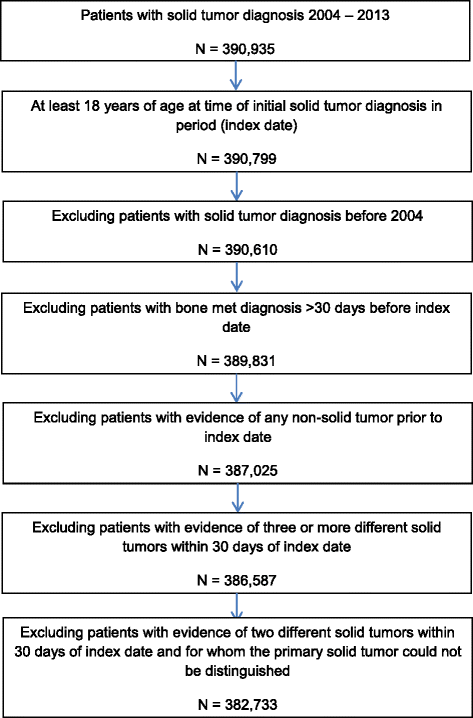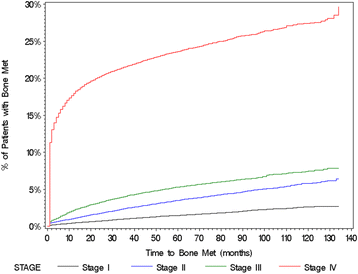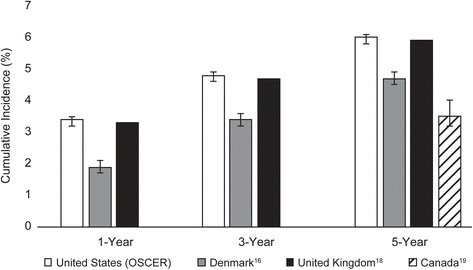Incidence of bone metastases in patients with solid tumors: analysis of oncology electronic medical records in the United States
- PMID: 29306325
- PMCID: PMC5756362
- DOI: 10.1186/s12885-017-3922-0
Incidence of bone metastases in patients with solid tumors: analysis of oncology electronic medical records in the United States
Abstract
Background: Bone metastases commonly occur in conjunction with solid tumors, and are associated with serious bone complications. Population-based estimates of bone metastasis incidence are limited, often based on autopsy data, and may not reflect current treatment patterns.
Methods: Electronic medical records (OSCER, Oncology Services Comprehensive Electronic Records, 569,000 patients, 52 US cancer centers) were used to identify patients ≥18 years with a solid tumor diagnosis recorded between 1/1/2004 and 12/31/2013, excluding patients with hematologic tumors or multiple primaries. Each patient's index date was set to the date of his or her first solid tumor diagnosis in the selection period. Kaplan-Meier analyses were used to quantify the cumulative incidence of bone metastasis with follow-up for each patient from the index date to the earliest of the following events: last clinic visit in the OSCER database, occurrence of a new primary tumor or bone metastasis, end of study (12/31/2014). Incidence estimates and associated 95% confidence intervals (CI) are provided for up to 10 years of follow-up for all tumor types combined and stratified by tumor type and stage at diagnosis.
Results: Among 382,733 study patients (mean age 64 years; mean follow-up 940 days), breast (36%), lung (16), and colorectal (12%) tumors were most common. Mean time to bone metastasis was 400 days (1.1 years). Cumulative incidence of bone metastasis was 2.9% (2.9-3.0) at 30 days, 4.8% (4.7-4.8) at one year, 5.6% (5.5-5.6) at two years, 6.9% (6.8-7.0) at five years, and 8.4% (8.3-8.5) at ten years. Incidence varied substantially by tumor type with prostate cancer patients at highest risk (18% - 29%) followed by lung, renal or breast cancer. Cumulative incidence of bone metastasis increased by stage at diagnosis, with markedly higher incidence among patients diagnosed at Stage IV of whom11% had bone metastases diagnosed within 30 days.
Conclusions: These estimates of bone metastasis incidence represent the experience of a population with longer follow-up than previously published, and represent experience in the recent treatment landscape. Underestimation is possible given reliance on coded diagnoses but the clinical detail available in electronic medical records contributes to the accuracy of these estimates.
Keywords: Bone metastasis; Epidemiology; Incidence; Solid tumor.
Conflict of interest statement
Ethics approval and consent to participate
The Institutional Review Board of each oncology practice approved collaboration to contribute data to a large longitudinal electronic health records database; informed patient consent was waived per the US framework for retrospective noninterventional studies. Individual patient-level data were protected against breach of confidentiality consistent with the final Health Insurance Portability and Accountability Act (HIPAA) Security Rule from the US Department of Health and Human Services.
Consent for publication
Not applicable.
Competing interests
RKH and AL are employees and stockholders of Amgen Inc. SW is employed by Wade Outcomes Research and Consulting which has conducted paid work for Amgen Inc. AR and MP are employees of IMS Health which has conducted paid work for Amgen Inc. GL is Principal Investigator on a research grant to the Fred Hutchinson Cancer Research Center from Amgen to study Febrile Neutropenia.
Publisher’s Note
Springer Nature remains neutral with regard to jurisdictional claims in published maps and institutional affiliations.
Figures




References
-
- Sathiakumar N, Delzell E, Morrisey MA, Falkson C, Yong M, Chia V, Blackburn J, Arora T, Brill I, Kilgore ML. Mortality following bone metastasis and skeletal-related events among women with breast cancer: a population-based analysis of U.S. Medicare beneficiaries, 1999-2006. Breast Cancer Res Treat. 2012;131(1):231–238. doi: 10.1007/s10549-011-1721-x. - DOI - PubMed
-
- Sathiakumar N, Delzell E, Morrisey MA, Falkson C, Yong M, Chia V, Blackburn J, Arora T, Kilgore ML. Mortality following bone metastasis and skeletal-related events among men with prostate cancer: a population-based analysis of US Medicare beneficiaries, 1999-2006. Prostate Cancer Prostatic Dis. 2011;14(2):177–183. doi: 10.1038/pcan.2011.7. - DOI - PubMed
Publication types
MeSH terms
LinkOut - more resources
Full Text Sources
Other Literature Sources
Medical

